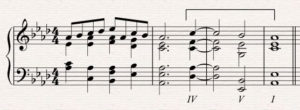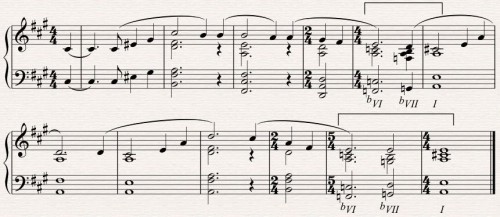Category: Music
King Wenceslas’ Feast
What Child is This
The Friendly Beasts
William and Kate and harmony
So this is a post about William and Kate’s wedding you aren’t likely to see anywhere else.
If you saw William and Kate’s wedding (and who didn’t?) you heard some very nice music.
One piece you heard was John Rutter’s “This is the Day”, written especially for the service.
Fairly traditional, but with some nice little twists that made it just a bit different, just a bit more contemporary. Just what was it that gave it that slightly modern flavor?
First, let’s look at a standard final chord progression (click on the scores to listen):

The first bar doesn’t matter. The idea is that some key is already established, in this case, Ab Major. The bracketed part is what is important. Also, the chord symbols are simplified, I’m only indicating the root motion and the basic chord quality. So the above is pretty standard fair, found in a lot of hymns and songs.
A slightly stronger version sounds like this:

The other day, I was listening to British composer Malcolm Williamson. Here’s what he did in one of his anthems:

Really nice. He’s dipping into Ab minor for a moment here. The V, Eb Major, is shared; it exists in both Ab harmonic minor and Ab Major and sort of bridges between the two.
Notice the root motion: a Major 2nd up ( iv -> V), followed by the traditional 5th down ( V -> I). That’s one of the ways you can tell it’s not my work. I tend to reverse those two motions, avoiding the traditional motion at the end. Like this:

So the 5th downward comes first ( iv -> bVII ), then the Major 2nd up ( bVII -> I ). The dip into Ab minor is firmly established as natural minor by the bVII, then the reversal back to major at the end (no ‘bridge’ needed!).
So now we’re ready to talk about John Rutter’s “This is the Day”. Of course, I haven’t seen the score, but I think I heard the essential harmonies correctly. At the end, a lesser composer would have written:

Again, the cadences in question are in brackets. Above, we have all 5th-down root motion: ii – V – I. Perfectly fine, but traditional enough to border on the trite. Below is what Rutter actually did:

All Major-second-up root motion. Makes a big difference doesn’t it? This is one of my favorite cadences. I use it all the time, and it works in many contexts. Traditional, yet modern at the same time.
So now you know.
Music files not restored yet
New Lyricism
I’ve been thinking about what makes my music part of New Lyricism. Actually, despite what I’ve said everywhere else on this site, I’m not sure that a tonal basis is the main ingredient. For me at least, the main ingredient is the personal, the audience of one. Most often, that audience of one is a performer, but not always. I can’t just sit down and write a piece. Or even write a piece for myself. I have to have someone in mind, someone who’ll be playing it or sitting in the audience that first performance. It’s got to be music that we’ll both like, that exists in some shared aesthetic space between us. Music that neither of us knew was there, yet we both recognize when we hear it.
And afterward, when the performance is over, whether we shake hands backstage, or just catch a glimpse of one another across a sea of faces in the audience, we know something new about one another, something that somehow helps describe who we are as people, and what is important to us. It has much the same feel as a shared joke, or witnessing an act of generosity or heroism; we now know something about that person that we can’t really put into words. Without that, it’s not New or Old or any other kind of Lyricism.